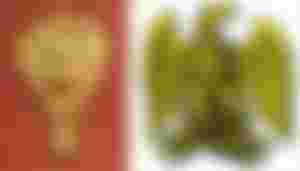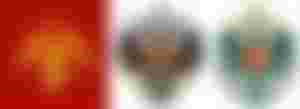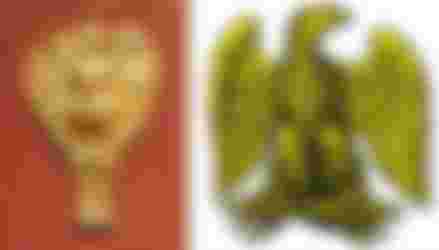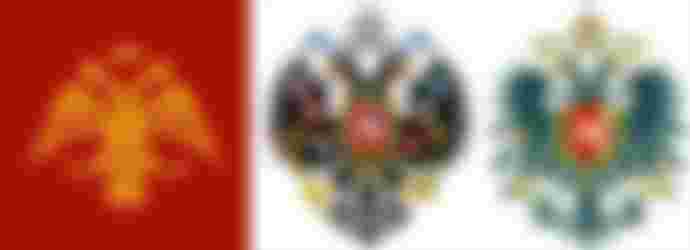A single eagle, single-headed or double-headed, turns up in the symbology of empires throughout history.
As a symbol of a ruler, we find eagles in the Antiquities. For the Greeks it was a symbol of Zeus, for the Romans of Jupiter. It is possible that it all derives from a symbol of Old Egyptian Horus. He is commonly associated with a falcon, but the borderline between the various species of predator birds here is floating.
There is a story of the seven eagles of Horus which, according to contemporary Bedouins west of Cairo, in Egypt, repeatedly turn up close to the old temple Abu Gorab. Always seven. There the predator bird, a symbol of Horus, is mixed with the sacred number seven. I have once seen these predator birds, even if I were not able to determine their exact species, and they were indeed seven. I don't want to draw any conclusions from that, but some history-minded Bedouins who live in the area venerate these “eagles”.
As an imperial symbol, the typical example of an eagle is the Roman Aquila, the standard of a Roman legion; and it was in Rome it became an imperial symbol when it was made the heraldic animal of Rome in 102 BC.
For a Roman legion, losing the Aquila was a great shame. The legion was disbanded in dishonour.
After the Romans, the eagle continued to be associated with imperial power, but also kings and nobles began using this symbol of strength and authority. It entered heraldry and can still be found on many coat of arms, flags, and emblems.
Napoleon, admiring old Rome, adopted the eagle symbol for his empire as well, and he imitated the use of the Aquila. He distributed eagles to his armies.
(Below: Roman ornament with an aquila (100–200 AD), from the Cleveland Museum of Art [left]; Aigle Empire - Napoleonic Eagle [right])

The double-headed eagle, however, first turned up amongst Sumerians and Hittites. In Sumer it was the symbol of Ninurta, a major deity.
The Byzantine Empire later re-introduced the old double-headed eagle into its symbology, which was also used by the Seljuq Turks and the Holy Roman Empire (although initially, the Holy Roman Empire used a single-headed eagle, a connection to ancient Rome).
Russia and several other Eastern European countries inherited the symbol from the Byzantines, although not all of them were empires, and none of them is today.

(Above: The Byzantine double-headed eagle under the dynasty of Palaiologos [left]; Coat of Arms of the Russian Empire [middle]; Imperial Coat of Arms of Austria, used from 1815 to 1866 [right].)
From the Holy Roman Empire, it was kept by the Austrians in their Empire, and was later used also by the Germans. All over these areas as well double-headed as single-headed eagles can be found still today, although all the empires are gone.
Below, we find the present Albanian flag [left]. Obviously, this symbol is an inheritance from the Byzantine double-headed eagle.

Finally, let us look at an example of a local flag with an eagle, a design adopted as late as 2009. It is the Lower Silesian Voivodeship flag [above, right], which shows that the eagle as a symbol is not only a relic, but a symbol that it is alive and well. A clearly modern design. Still a symbol of strength and authority. The empires, however, are all gone.
In Muslim symbology, there are two eagles, or predator birds, we have to include here: The Eagle of Saladin & The Hawk of Quraish.
Without formally being so, Saladin's Ayybid dynasty ruled over a de facto empire. I have previously written about Saladin and his eagle (with history & image) and will not repeat it here. If The Eagle Of Saladin was really used by Saladin himself (which is a matter of doubt), his eagle can be seen as an imperial symbol.
There is also another bird of prey in Muslim heraldry, "The Hawk of Quraish" [Saqr Quraish; بصقر قريش]. Quraish, the tribe of the Prophet Muhammed, used such a "hawk" as a symbol, and it appears as a heraldic symbol in several Arab countries. For example, in the arms of the United Arab Emirates (left); on the coat of arms of Libya from 1977 to 2011 (middle); on the coat of arms of the Federation of Arab Republics (Egypt, Syria, Libya).

It can be discussed if "The Hawk of Quraish" in a strict sense is an imperial symbol, but I chose to include it here anyway.
Related articles:
Saladin & The Ayyubid Dynasty - Saladin's Eagle, and Saladin's Citadel
The Crocodile, a Symbol of Egypt?
From the Sacred Cobras of Egypt to Quezalcoatl: Serpents & Snakes in Mythology
Snakes in Astrology & Heraldry
Fleur-de-lis & The Lily of Florence
La Tricolore: What is the Origin of Its Colours and Design?
The Star-And-Crescent - A Symbol for Islam?
Nisshōki, Taegeukgi & the Nordic Cross
Copyright © 2017, 2021 Meleonymica/Mictorrani. All Rights Reserved.
(Lead image: Painting by Jacques Louis David: Serment de l'armée fait à l'Empereur [Napoleon I] après la distribution des aigles 5 décembre 1804. In the Public Domain.)
Here you find my articles related to symbols, and to history.
Interested in history, legends and myths, join my community History, Myths, Legends & Mysteries (be45).
You find all my writings on Read.Cash, sorted by topic, here.
Read also: What You Need to Know about Copyright




What great facts! It clears certain things, I thought eagles just symbolize freedom, but I think symbolism extends when you read historical facts.